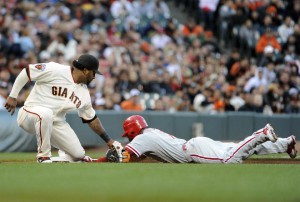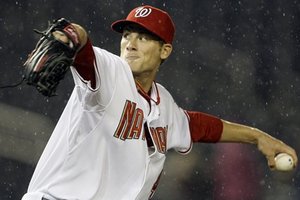
Jimmy Rollins steals lots of bases: did he steal one too many vs the Giants friday night? Photo: Thearon Henderson/Getty Images
(editor’s note: this post started with an email conversation amongst friends, where the Phillies fan amongst us didn’t think Rollin’s steal was “bad baseball.”)
The Giants and Phillies mixed it up in Friday 8/5’s game, a 9-2 victory (box/gamer) for Philadelphia that featured some “unwritten rule” discussion over the actions of Jimmy Rollins and subsequently Giant’s reliever Ramon Ramirez.
Here was the situation: the Phillies had just scored 2 runs to extend their lead to 8-2 in the top of the 6th inning. The Giant’s starter Jonathan Sanchez had been knocked out of the game, and reliever Ramirez gave up a 2-run scoring single to Rollins. Rollins promptly stole second base, and the next pitch plunked batter Shane Victorino.
Honestly, I believe it was a deserving retaliation by Ramirez and/or the Giants. Stealing with a lead is a sliding scale; had Rollins done it in the 2nd inning with a 3-run lead it wouldn’t have gone punished, but the 6th is iffy with a 6 run lead. Essentially, when the game appears to be out of reach, major leaguers have a tendency to just “play out the string” and expect this “conceding behavior” to be matched by the winning team. Having been on both sides of many blowouts, there’s definitively a list of things you don’t do with a massive lead. Steals and bunts are definitely out. Curtailing aggressive play (taking extra bases, take-out slides, etc), swinging at 3-0 pitches and swinging out of your ass trying to hit homers are all examples of no-nos. Certainly admiring homers and showing up a pitcher is a no-no, at nearly any point in the game (the Weaver incident earlier this week).
My Phillies friend apologist countered that the game was still close enough, that the Giants still had 4 at-bats, and the steal (though borderline) was justified.
Here’s some stats on the Giant’s offense and their capabilities of coming back, courtesy of baseball-reference.com:
- The Giants are 0-8 when giving up 8 or more runs in a game.
- They’re 12-26 when trailing after the 5th, no matter how many runs they’re down. And,
- The largest comeback they’ve had all season in being behind 4 runs.
I’d like to find some stats on how often baseball teams make up X-run leads, but my google skills are failing me. I’m pretty certain though that the likelihood of making up 6 run deficits is pretty slim. Tom Boswell has done research that shows that about half of all baseball victories feature more runs scored by the winning team in ONE inning than the loser scores the entire game (his “Big Bang” theory, based on his own research). Sure enough, the Phillies scored more runs in the 5th inning (four) than the Giants did the entire game (two).
For me, the play was bush league, broke the unwritten rules of showing up your competitors and/or running up the score, and the retaliation was not only deserved but expected.
What do you think?
